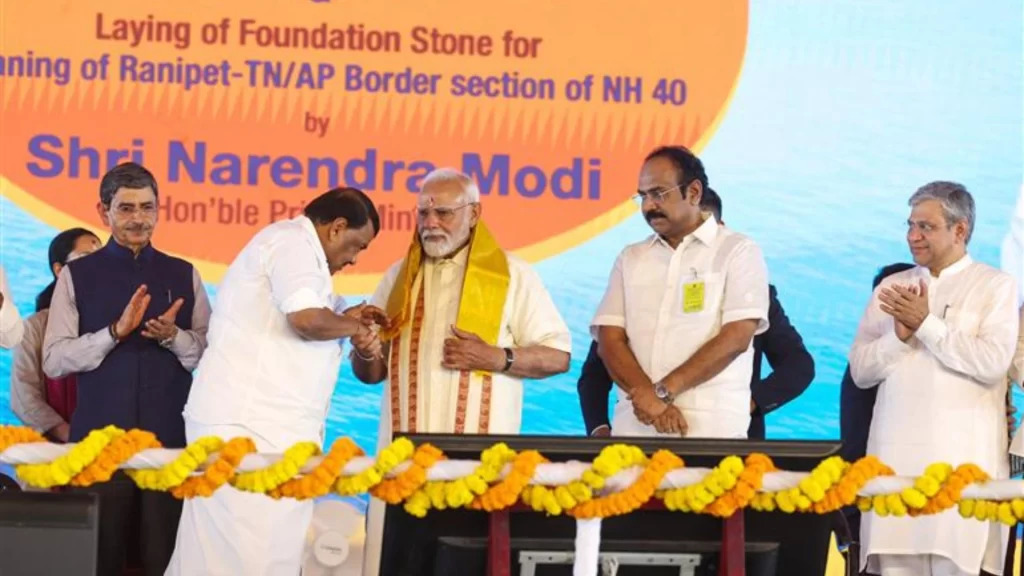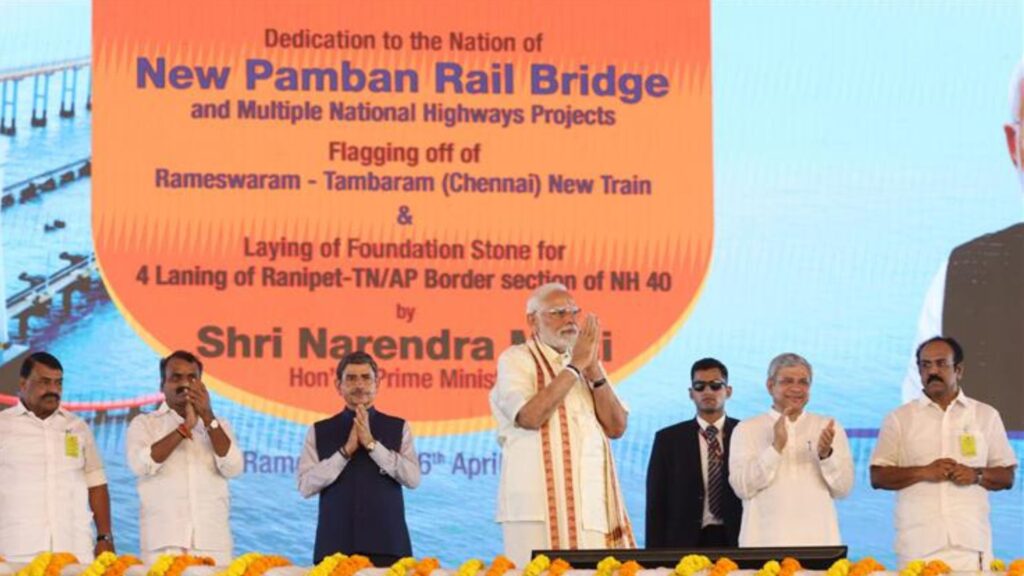In a landmark moment for southern India, PM Modi launched a flurry of high-impact infrastructure projects worth over ₹8,300 crore in the sacred town of Rameswaram, Tamil Nadu, marking a major stride in India’s development journey. With the inauguration of India’s first vertical lift sea bridge—the New Pamban Rail Bridge—and a series of road and rail projects, the Prime Minister reaffirmed the government’s vision of blending technological innovation with cultural heritage.
PM Modi offered prayers at the revered Ramanathaswamy Temple:
On the auspicious occasion of Ram Navami, Prime Minister Modi began the day by offering prayers at the revered Ramanathaswamy Temple, describing the experience as deeply spiritual. “I feel blessed to have prayed at the Ramanathaswamy temple today,” he remarked, adding a symbolic dimension to a day that saw the union of spiritual legacy and infrastructural advancement.
The crown jewel of today’s proceedings was the inauguration of the New Pamban Bridge, a marvel of modern engineering that connects the mainland with the sacred island of Rameswaram. Calling it a “fusion of tradition and technology,” PM Modi said, “A town thousands of years old is now connected by a 21st-century engineering wonder.”

The bridge, constructed at a cost of over ₹700 crore, is India’s first vertical lift railway sea bridge. It spans 2.08 kilometers and features a 72.5-meter lift span that rises 17 meters to allow passage for ships. Made from corrosion-resistant materials and designed to withstand the coastal climate, the bridge is a symbol of sustainable, future-ready infrastructure.
PM Modi also flagged off a new train service between Rameswaram and Tambaram (Chennai) and launched a ship service, reinforcing the Centre’s commitment to enhanced connectivity.
From Rameswaram to Chennai and beyond, the new projects are designed to improve regional connectivity and promote economic growth. “These rail and road projects will boost tourism, create jobs, and increase trade opportunities,” the Prime Minister asserted, noting that long-pending demands have finally been met.
Among the key projects launched were:
- Four-laning of the 28 km Walajapet–Ranipet section of NH-40
- Completion of the 29 km Viluppuram–Puducherry section of NH-332
- The 57 km Poondiyankuppam–Sattanathapuram section of NH-32
- The 48 km Cholapuram–Thanjavur stretch of NH-36
These upgrades are not just about ease of travel. They’re vital arteries linking major pilgrimage sites, tourist destinations, ports, and industrial hubs. They also support agricultural economies by helping farmers and small industries access broader markets more efficiently.
Reflecting on India’s infrastructural growth over the past ten years, the Prime Minister stated that the country’s economy has doubled in size, thanks in large part to massive investments in infrastructure. “In the past decade, the budget for railways, roads, ports, airports, electricity, and water pipelines has increased nearly sixfold,” he noted.
PM Modi highlighted iconic projects across India—the Atal Setu in Mumbai, the Bogibeel Bridge in Assam, and the Chenab Bridge in Jammu and Kashmir—as testaments to the country’s transformation. “Today, mega projects are progressing rapidly across the country,” he said, emphasizing that India is on track to realize its developed nation dream.
The Prime Minister showered praise on Tamil Nadu, describing it as a key pillar of India’s development. He announced that the central government has tripled its funding for the state compared to the pre-2014 era. Notably, the railway budget for Tamil Nadu has increased from ₹900 crore to over ₹6,000 crore this year. Modernization of 77 railway stations, including Rameswaram, is underway.
The state has also seen record growth in road construction, with over 4,000 kilometers built since 2014. Chennai Metro and other public transport initiatives continue to make travel more efficient for Tamil Nadu’s citizens.
Infrastructure was not the only highlight. The Prime Minister detailed the impact of the government’s social welfare schemes in Tamil Nadu. Over 12 lakh pucca houses have been constructed under PM Awas Yojana, and 1.11 crore rural households now enjoy piped water access for the first time.
In healthcare, Ayushman Bharat has delivered over 1 crore treatments in the state, saving families around ₹8,000 crore. The 1,400+ Jan Aushadhi Kendras in Tamil Nadu are ensuring affordable medicines, collectively saving citizens over ₹700 crore.
PM Modi also emphasized the importance of education and healthcare accessibility, urging the Tamil Nadu government to offer medical courses in Tamil language to empower rural students.
Boosting Blue Economy and Farmer Welfare
The Prime Minister hailed Tamil Nadu’s contributions to the Blue Economy, acknowledging its fisheries sector and the hardworking coastal communities. With strategic investments in fishing harbours, landing centers, and seaweed parks, the government is turning coastal development into a national growth engine.
He also highlighted the rescue of more than 3,700 Indian fishermen from Sri Lanka over the past decade, including 600 in the last year alone, showing the government’s commitment to their safety.
Farmers have not been left behind either. Nearly ₹12,000 crore has been disbursed under PM Kisan Samman Nidhi in Tamil Nadu, while claims worth ₹14,800 crore were settled under the PM Fasal Bima Yojana.
Finally, PM Modi emphasized the role of culture and language in India’s global image. “We are working to ensure that the Tamil language and heritage reach every corner of the world,” he said, asserting that the 21st century belongs to India’s civilizational greatness.
He expressed confidence that Tamil Nadu—steeped in spiritual heritage and surging ahead with infrastructure—will continue to energize India’s development.
As the foundation stones were laid and engines roared to life across Tamil Nadu, the day marked more than the inauguration of projects—it symbolized a power-packed leap into a future where heritage and high-tech coexist. With vision, commitment, and unity, India’s path to becoming a developed nation is clearer than ever.





